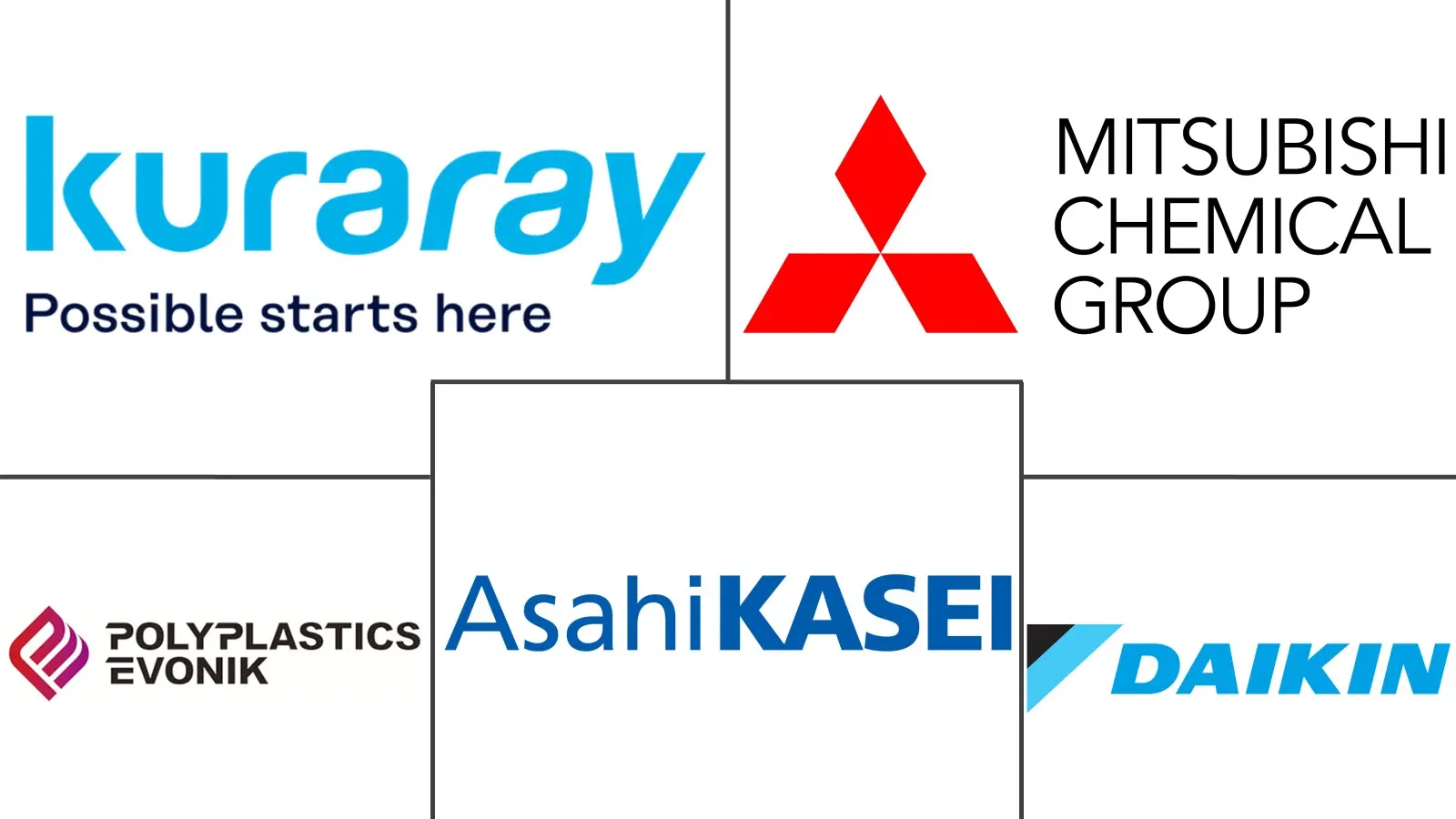Japan Engineering Plastics Market Size and Share
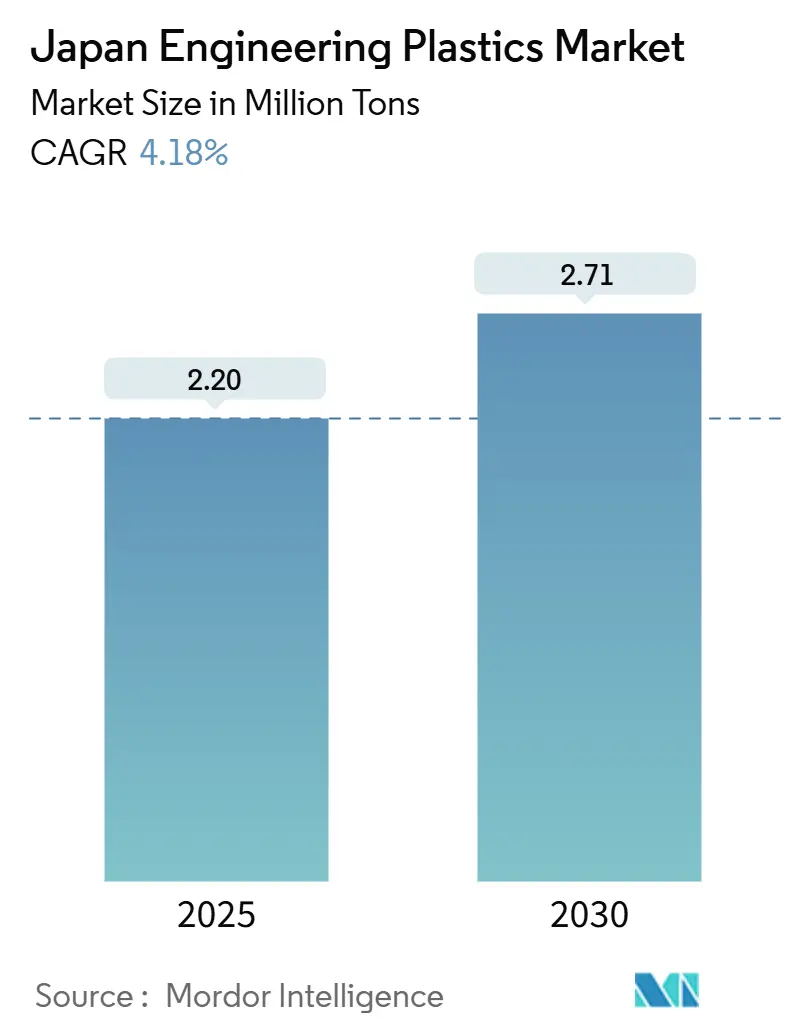
Japan Engineering Plastics Market Analysis by Mordor Intelligence
The Japan Engineering Plastics Market size is estimated at 2.20 million tons in 2025, and is expected to reach 2.71 million tons by 2030, at a CAGR of 4.18% during the forecast period (2025-2030). Structural changes in Japan’s manufacturing base are driving this expansion: packaging conversions to chemically recycled PET, electronics miniaturization that favors high-temperature polymers, and medical device demand tied to a rapidly aging population. Domestic electric-vehicle (EV) lightweighting programs are accelerating the adoption of specialty-grade materials, while the national PFAS phase-out is driving material substitutions that divert additional volumes into polyamide tribological grades. The convergence of circular-economy regulation and corporate net-zero targets is reshaping competitive dynamics, prompting producers to invest in chemical recycling pathways and bio-derived feedstocks. Despite near-term margin pressure from volatile naphtha costs, high-value applications in 5G infrastructure and semiconductor packaging continue to offset softness in legacy automotive volumes.
Key Report Takeaways
- By resin type, polyethylene terephthalate (PET) held 28.50% of the Japanese engineering plastics market share in 2024. Fluoropolymers are projected to record the fastest 6.44% CAGR through 2030.
- By end-user industry, packaging captured 28.89% of the volume share in 2024, whereas electrical and electronics is set to advance at a 6.37% CAGR to 2030.
Japan Engineering Plastics Market Trends and Insights
Drivers Impact Analysis
| Driver | (~) % Impact on CAGR Forecast | Geographic Relevance | Impact Timeline |
|---|---|---|---|
| Lightweighting push from domestic EV makers | +0.8% | Toyota City, Hiroshima, Kanagawa | Medium term (2-4 years) |
| Surge in 5G & advanced semiconductor packaging | +1.2% | Tokyo–Osaka corridor, Kyushu cluster | Short term (≤ 2 years) |
| Aging-society demand for medical devices | +0.9% | National metro areas | Long term (≥ 4 years) |
| PFAS phase-out creating PA tribological grades | +0.6% | Chiba, Osaka, Aichi | Medium term (2-4 years) |
| Cloud-based polymer CAE boosting high-turnover SKUs | +0.4% | Tokyo, Tsukuba, Osaka | Short term (≤ 2 years) |
| Source: Mordor Intelligence | |||
Lightweighting Push from Domestic EV Makers Accelerates Material Innovation
Domestic automakers are wielding weight-reduction targets as a lever to prolong battery range and comply with Japan’s Top Runner fuel-efficiency standards. Toyota’s current-generation Prius Prime cut curb weight 15% by replacing selected steel stampings with carbon-fiber-reinforced plastics (CFRP) and high-rigidity polyamide brackets[1]Toyota Motor Corporation, “Prius Prime Design Insights,” global.toyota. Honda deepened its partnership with Toray to chemically recycle post-consumer polyamide into high-quality pellets for under-hood parts, linking circularity with mass reduction goals. The incremental cost of premium resins is justified by the total-cost-of-ownership savings delivered through lighter vehicles that require smaller battery packs. Material suppliers, meanwhile, are retrofitting compounding lines for glass-fiber-reinforced PA66, PBT, and polyketone to meet new mechanical load cases. As OEM lightweight scorecards become audit items in annual vendor evaluations, engineering-plastics formulators able to document CO₂ savings and secondary-recycle pathways are winning multi-platform nominations.
Surge in 5G & Advanced Semiconductor Packaging Creates Precision Material Demand
Japan’s aggressive 5G rollout—supported by capital expenditure (capex) incentives in the Digital Garden City Initiative—is triggering record orders for liquid-crystal polymer (LCP) and polyimide films used in flexible printed circuits. Base-station OEMs require dielectric-constant values below 3.0 at 28 GHz, pushing converters to specify resins that maintain signal integrity after multiple reflow cycles. Asahi Kasei’s cloud-based polymer CAE has reduced grade-customization time from 20 weeks to under 6 weeks, shortening design win cycles for antenna modules. In semiconductor back-end packaging, polyether-ether-ketone (PEEK) sockets deliver dimensional stability at 260°C reflow conditions, while high-temperature polyimide underfills protect chiplet architectures. IEC compliance audits reinforce supplier lock-in, advantaging incumbents with accredited labs. The concentration of foundry investment in Kyushu is localizing polymer sourcing and creating regional supply-chain clusters for compounders.
Aging-Society Demand for Medical Devices Drives Biocompatible Material Innovation
With 29.1% of Japan’s population aged 65 and above in 2025, minimally invasive surgical procedures are scaling rapidly. PEEK spinal cages now dominate lumbar fusion implants due to their biomechanical compatibility and radiolucency, resulting in double-digit volume growth. Japan Medical Device Industry Association data show that cardiac and neuro-stimulation leads are adopting aromatic polyamide insulation, which sustains flex cycles over decades. Regulatory approvals by the Pharmaceutical and Medical Devices Agency follow ISO 10993 protocols, which extend development timelines but secure durable product life cycles for qualified materials. Medical-grade chemical recycling remains in its early stages; nonetheless, Toray’s pilot mechanical-recycling line for single-use endoscope components demonstrates feasibility within closed-loop hospital systems. Insurers are beginning to reimburse device makers for demonstrable reductions in waste disposal costs, indirectly incentivizing recyclable engineering-plastic designs.
PFAS Phase-out Creating Opportunities for PA Tribological Grades
The January 2025 ban on 138 PFOA-related substances eliminated a range of fluoropolymer-lubricated bearings, gears, and valves. Mitsubishi Chemical responded by commercializing PA66 compounds with embedded solid lubricants, hitting coefficients of friction below 0.15 while maintaining -40°C impact toughness. Early adopters in automotive fuel-handling systems and industrial robotics are validating these grades in accelerated wear rigs, positioning polyamide to displace legacy PTFE composites. New entrants face safety assessments under the Chemical Substances Control Law that can extend beyond 18 months, thereby protecting first movers’ market foothold. The shift is most visible in industrial regions surrounding Osaka and Nagoya, where machining centers previously dedicated to PTFE rings are being re-tooled for precision PA components.
Restraints Impact Analysis
| Restraint | (~) % Impact on CAGR Forecast | Geographic Relevance | Impact Timeline |
|---|---|---|---|
| Feedstock price volatility | -1.10% | National, with particular impact on coastal petrochemical complexes in Chiba, Osaka Bay, Mizushima | Short term (≤ 2 years) |
| Automotive output contraction 2023-24 | -0.70% | Toyota City, Hiroshima, Kanagawa automotive corridors | Medium term (2-4 years) |
| PFAS regulatory uncertainty for fluoropolymers | -0.50% | Chemical manufacturing centers in Chiba, Osaka, Kanagawa with fluoropolymer production | Short term (≤ 2 years) |
| Source: Mordor Intelligence | |||
Feedstock Price Volatility Pressures Margin Sustainability
Japan’s import-dependent petrochemical chain saw naphtha prices swing 40% during 2024 due to Middle East supply disruptions. Smaller specialty compounders lacking hedging capacity experienced negative operating margins, prompting spot price surcharges that strained downstream converters. Mitsui Chemicals has begun allocating investment toward bio-based naphtha produced from used cooking oil, aiming to reduce its exposure to fossil feedstocks by 10% by 2027[2]Mitsui Chemicals, “Bio-naphtha Procurement Strategy,” mitsuichem.com. Carbon-pricing schemes under the GX League increase the urgency, as scope 1 emissions costs erode competitiveness against overseas suppliers with integrated ethane crackers. While chemical recycling yields help diversify monomer inputs, scaling remains capital-intensive, and output consistency challenges prevent immediate relief for high-volume grades.
Automotive Output Contraction Creates Demand Uncertainty
Domestic vehicle assemblies reached a 35-year low in 2024, reducing ethylene demand by nearly one-third. Traditional under-hood and interior plastics, therefore, faced abrupt order reductions, leaving processors with excess capacity. In response, Idemitsu, Mitsui, and Sumitomo are merging polyolefin assets to realize feedstock synergies and rationalize plant networks. Although EV component demand partially offsets the volume decline, qualification cycles for battery housings and high-voltage connectors stretch over multiple model years, delaying revenue capture. Export opportunities remain limited because Southeast Asian assemblers are increasingly sourcing locally to meet content rules, compelling Japanese suppliers to establish offshore compounding satellites.
Segment Analysis
By Resin Type: PET Dominance Challenged by Fluoropolymer Innovation
Polyethylene terephthalate (PET) accounted for 28.50% of the Japanese engineering plastics market share in 2024, equivalent to approximately 0.60 million tons, primarily driven by beverage and food packaging applications. JEPLAN’s chemically recycled bottles demonstrate the feasibility of a closed loop, reinforcing PET’s incumbency even as regulatory scrutiny of single-use plastics intensifies. The Japan engineering plastics market size attributable to fluoropolymers is expanding at a brisk 6.44% CAGR, fueled by irreplaceable roles in 5G antenna substrates and EUV lithography tool components. First-generation fluoropolymers subject to PFAS curbs are being replaced by next-generation, low-fluorine chemistries; however, functional drop-in substitutes remain elusive, thereby maintaining pricing power for compliant grades.
In contrast, polycarbonate volumes stagnate; however, Teijin’s biomass-derived PC with ISCC Plus certification has carved out a niche in premium consumer electronics, offering OEMs carbon footprint reductions without compromising impact resistance. PEEK and polyimide continue to command premium margins in aerospace fasteners and thermal-barrier films. Collectively, high-performance resins such as PEEK now represent under 3% of volume yet contribute more than 12% of segment revenue, underscoring a structural shift toward value-added formulations within the broader Japan engineering plastics market.
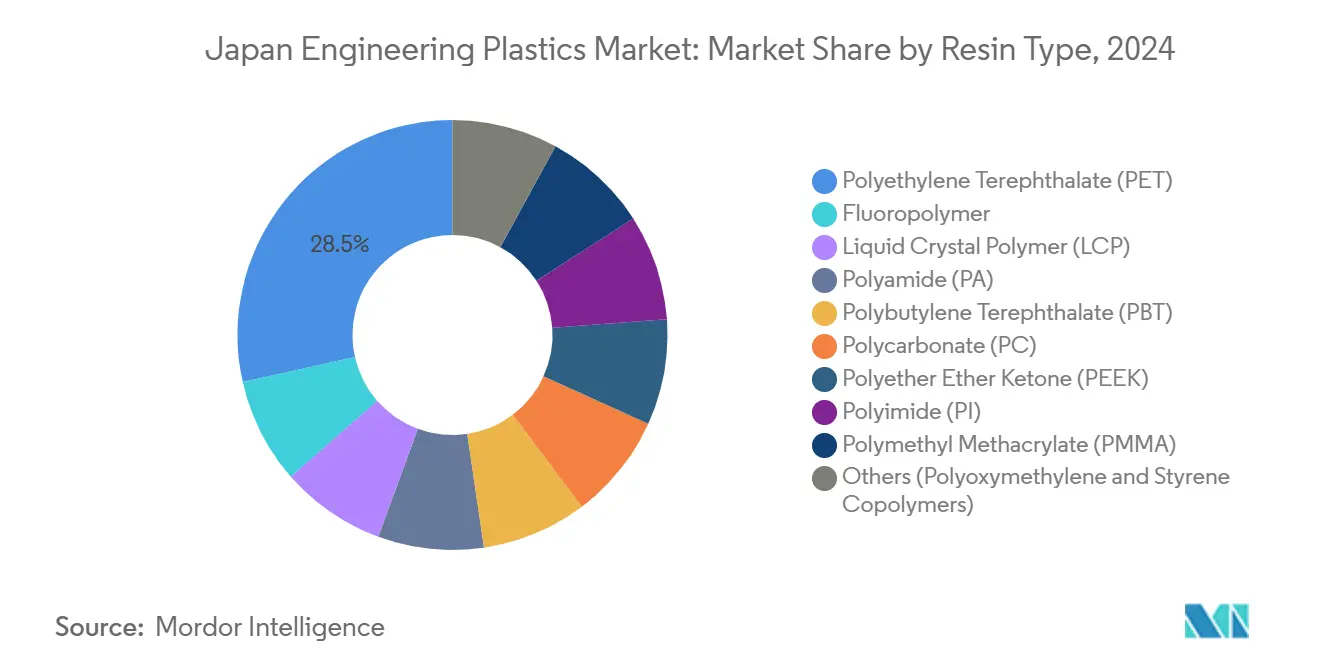
Note: Segment shares of all individual segments available upon report purchase
By End-User Industry: Electronics Surge Reshapes Application Landscape
Packaging retained 28.89% of total volume in 2024, reflecting consumer demand for lightweight, resealable solutions and municipal mandates for recyclability. Nevertheless, the Japan engineering plastics market size linked to electrical & electronics applications is on track to climb at a 6.37% CAGR through 2030, outpacing every other sector. Smartphones, base stations, and smart factory sensors increasingly specify LCP, PI, and PBT for high-frequency or flame-retardant applications.
The automotive share contracted in tandem with domestic assembly declines; however, EV battery enclosures and ADAS radar housings are generating new resin demand profiles, particularly for glass-fiber-reinforced PBT and PC blends engineered for enhanced thermal conductivity. Medical devices, although a smaller slice, provide a resilient growth vector as orthopedic implant volumes rise in tandem with aging demographics. Building and construction uptake remains stable, primarily in daylight roofing and seismic retrofit components that utilize PC sheet durability. Industrial robotics and machinery are expected to exhibit incremental volume gains through 2030, driven by Japan’s factory automation push, ensuring diversified demand across the Japanese engineering plastics market.
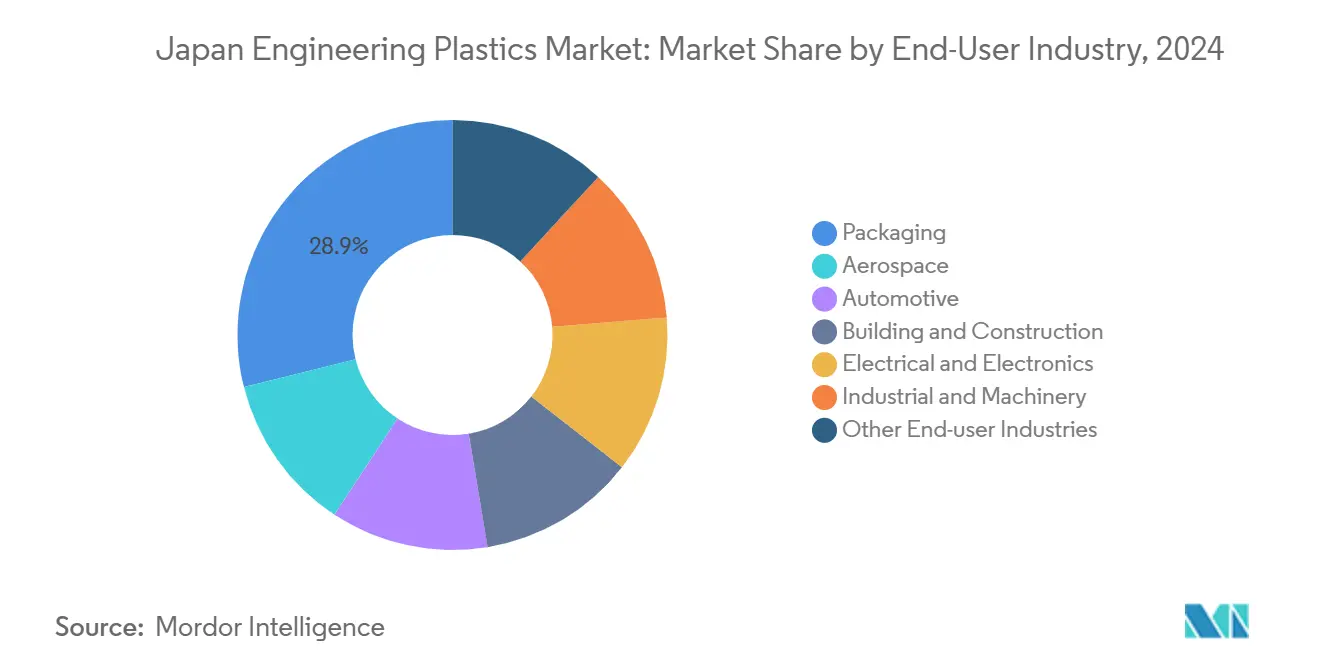
Note: Segment shares of all individual segments available upon report purchase
Geography Analysis
Japan’s eastern industrial corridor, stretching from Tokyo to Osaka, consumed nearly 60% of engineering plastics volume in 2024, given its dense cluster of automotive, electronics, and precision gear producers. Local governments encourage circular-procurement schemes, prompting converters to integrate chemically recycled resins into municipal infrastructure projects. Kyushu recorded the fastest 5.8% CAGR and is poised to absorb a larger share of the Japanese engineering plastics maccounted for nearly 60% of the engineering plastics volume in 2024, due to its dense cluster of automotive, electronics, and precision gear manufacturers as Sony, Mitsubishi Chemical, and Taiwan’s TSMC invest capital in semiconductor fabs around Kumamoto. Downstream toolmakers are co-locating compounding lines to minimize logistics costs and strengthen just-in-time delivery models.
Chubu’s Nagoya hub, historically tied to Toyota’s supplier network, is diversifying into EV drivetrain components and composite body panels. Demand volatility persists, yet Tier 1 system integrators are locking in multi-year contracts for flame-retardant PA and PPS. Kansai’s chemical complex near Osaka benefits from deepwater port access that streamlines the import of monomers and the export of high-value compounds. Conversely, Hokkaido and Tohoku are emerging as centers for renewable energy components; wind-turbine gearbox casings and large-format battery housings utilize glass-fiber-reinforced PBT sourced from local compounders.
Regional policy heterogeneity shapes material selection. Tokyo mandates 60% recycled content in designated public-procurement plastic items, nudging specifiers toward chemically recycled PET and mechanically recycled PC. Prefectures such as Fukuoka offer R&D tax credits for bio-based resin development, attracting startups to university-linked incubators. Collectively, these dynamics create a geographically stratified demand matrix inside the Japan engineering plastics market.
Competitive Landscape
The Japan Engineering Plastics market is moderately consolidated. Regulatory compliance now functions as a competitive moat; companies with in-house toxicology labs can document additive safety more quickly under Japan’s PFAS and food-contact rules. Supply-chain partnerships extend beyond resin sales to include lifecycle-assessment data and take-back schemes. Overall, competitive thrusts are shifting from price to sustainability credentialing within the Japan engineering plastics market.
Japan Engineering Plastics Industry Leaders
-
Mitsubishi Chemical Corporation
-
Asahi Kasei Corporation
-
Polyplastics-Evonik Corporation
-
Daikin Industries Ltd.
-
Kuraray Co., Ltd.
- *Disclaimer: Major Players sorted in no particular order
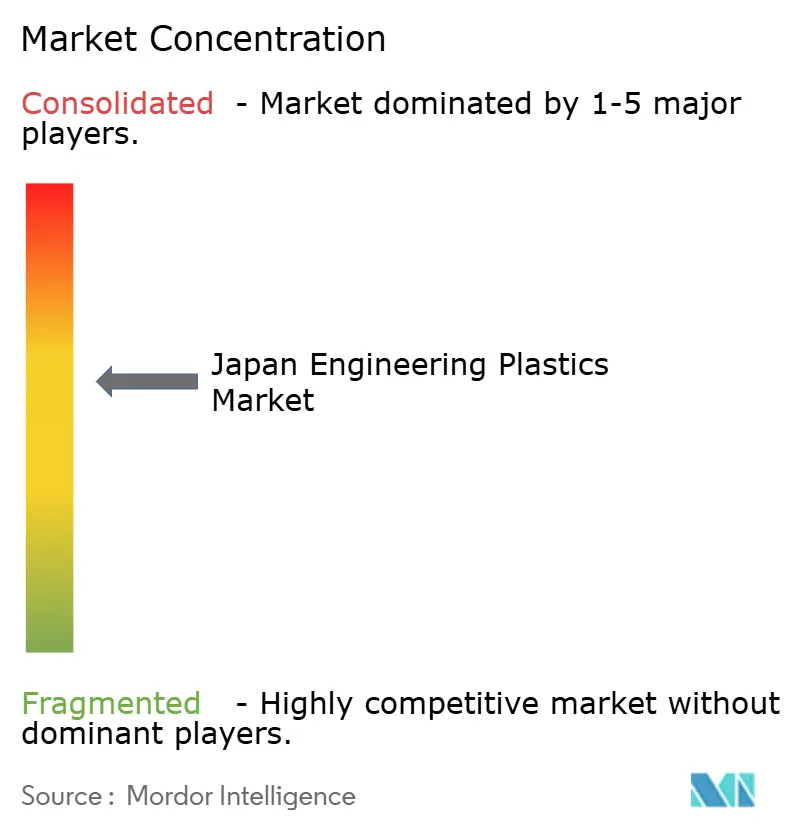
Recent Industry Developments
- April 2025: Teijin Limited has announced the rollout of initiatives to integrate aramid fibers and carbon fibers with Digital Product Passport (DPP) technology, which enhances supply chain transparency by verifying the origins of materials and supporting sustainability claims.
- March 2025: Sumitomo Chemical Co., Ltd. announced plans to market polymethyl methacrylate (PMMA) made from chemically recycled methyl methacrylate (MMA) monomer. LG Display Co., Ltd. and Nissan Motor Co., Ltd. decided to use this recycled material in their products.
Japan Engineering Plastics Market Report Scope
Aerospace, Automotive, Building and Construction, Electrical and Electronics, Industrial and Machinery, Packaging are covered as segments by End User Industry. Fluoropolymer, Liquid Crystal Polymer (LCP), Polyamide (PA), Polybutylene Terephthalate (PBT), Polycarbonate (PC), Polyether Ether Ketone (PEEK), Polyethylene Terephthalate (PET), Polyimide (PI), Polymethyl Methacrylate (PMMA), Polyoxymethylene (POM), Styrene Copolymers (ABS and SAN) are covered as segments by Resin Type.| Fluoropolymer | Ethylenetetrafluoroethylene (ETFE) |
| Fluorinated Ethylene-propylene (FEP) | |
| Polytetrafluoroethylene (PTFE) | |
| Polyvinylfluoride (PVF) | |
| Polyvinylidene Fluoride (PVDF) | |
| Other Sub Resin Types | |
| Liquid Crystal Polymer (LCP) | |
| Polyamide (PA) | Aramid |
| Polyamide (PA) 6 | |
| Polyamide (PA) 66 | |
| Polyphthalamide | |
| Polybutylene Terephthalate (PBT) | |
| Polycarbonate (PC) | |
| Polyether Ether Ketone (PEEK) | |
| Polyethylene Terephthalate (PET) | |
| Polyimide (PI) | |
| Polymethyl Methacrylate (PMMA) | |
| Polyoxymethylene (POM) | |
| Styrene Copolymers (ABS, SAN) |
| Aerospace |
| Automotive |
| Building and Construction |
| Electrical and Electronics |
| Industrial and Machinery |
| Packaging |
| Other End-user Industries |
| By Resin Type | Fluoropolymer | Ethylenetetrafluoroethylene (ETFE) |
| Fluorinated Ethylene-propylene (FEP) | ||
| Polytetrafluoroethylene (PTFE) | ||
| Polyvinylfluoride (PVF) | ||
| Polyvinylidene Fluoride (PVDF) | ||
| Other Sub Resin Types | ||
| Liquid Crystal Polymer (LCP) | ||
| Polyamide (PA) | Aramid | |
| Polyamide (PA) 6 | ||
| Polyamide (PA) 66 | ||
| Polyphthalamide | ||
| Polybutylene Terephthalate (PBT) | ||
| Polycarbonate (PC) | ||
| Polyether Ether Ketone (PEEK) | ||
| Polyethylene Terephthalate (PET) | ||
| Polyimide (PI) | ||
| Polymethyl Methacrylate (PMMA) | ||
| Polyoxymethylene (POM) | ||
| Styrene Copolymers (ABS, SAN) | ||
| By End-User Industry | Aerospace | |
| Automotive | ||
| Building and Construction | ||
| Electrical and Electronics | ||
| Industrial and Machinery | ||
| Packaging | ||
| Other End-user Industries | ||
Market Definition
- End-user Industry - Packaging, Electrical & Electronics, Automotive, Building & Construction, and Others are the end-user industries considered under the engineering plastics market.
- Resin - Under the scope of the study, consumption of virgin resins like Fluoropolymer, Polycarbonate, Polyethylene Terephthalate, Polybutylene Terephthalate, Polyoxymethylene, Polymethyl Methacrylate, Styrene Copolymers, Liquid Crystal Polymer, Polyether Ether Ketone, Polyimide, and Polyamide in the primary forms are considered. Recycling has been provided separately under its individual chapter.
| Keyword | Definition |
|---|---|
| Acetal | This is a rigid material that has a slippery surface. It can easily withstand wear and tear in abusive work environments. This polymer is used for building applications such as gears, bearings, valve components, etc. |
| Acrylic | This synthetic resin is a derivative of acrylic acid. It forms a smooth surface and is mainly used for various indoor applications. The material can also be used for outdoor applications with a special formulation. |
| Cast film | A cast film is made by depositing a layer of plastic onto a surface then solidifying and removing the film from that surface. The plastic layer can be in molten form, in a solution, or in dispersion. |
| Colorants & Pigments | Colorants & Pigments are additives used to change the color of the plastic. They can be a powder or a resin/color premix. |
| Composite material | A composite material is a material that is produced from two or more constituent materials. These constituent materials have dissimilar chemical or physical properties and are merged to create a material with properties unlike the individual elements. |
| Degree of Polymerization (DP) | The number of monomeric units in a macromolecule, polymer, or oligomer molecule is referred to as the degree of polymerization or DP. Plastics with useful physical properties often have DPs in the thousands. |
| Dispersion | To create a suspension or solution of material in another substance, fine, agglomerated solid particles of one substance are dispersed in a liquid or another substance to form a dispersion. |
| Fiberglass | Fiberglass-reinforced plastic is a material made up of glass fibers embedded in a resin matrix. These materials have high tensile and impact strength. Handrails and platforms are two examples of lightweight structural applications that use standard fiberglass. |
| Fiber-reinforced polymer (FRP) | Fiber-reinforced polymer is a composite material made of a polymer matrix reinforced with fibers. The fibers are usually glass, carbon, aramid, or basalt. |
| Flake | This is a dry, peeled-off piece, usually with an uneven surface, and is the base of cellulosic plastics. |
| Fluoropolymers | This is a fluorocarbon-based polymer with multiple carbon-fluorine bonds. It is characterized by high resistance to solvents, acids, and bases. These materials are tough yet easy to machine. Some of the popular fluoropolymers are PTFE, ETFE, PVDF, PVF, etc. |
| Kevlar | Kevlar is the commonly referred name for aramid fiber, which was initially a Dupont brand for aramid fiber. Any group of lightweight, heat-resistant, solid, synthetic, aromatic polyamide materials that are fashioned into fibers, filaments, or sheets is called aramid fiber. They are classified into Para-aramid and Meta-aramid. |
| Laminate | A structure or surface composed of sequential layers of material bonded under pressure and heat to build up to the desired shape and width. |
| Nylon | They are synthetic fiber-forming polyamides formed into yarns and monofilaments. These fibers possess excellent tensile strength, durability, and elasticity. They have high melting points and can resist chemicals and various liquids. |
| PET preform | A preform is an intermediate product that is subsequently blown into a polyethylene terephthalate (PET) bottle or a container. |
| Plastic compounding | Compounding consists of preparing plastic formulations by mixing and/or blending polymers and additives in a molten state to achieve the desired characteristics. These blends are automatically dosed with fixed setpoints usually through feeders/hoppers. |
| Plastic pellets | Plastic pellets, also known as pre-production pellets or nurdles, are the building blocks for nearly every product made of plastic. |
| Polymerization | It is a chemical reaction of several monomer molecules to form polymer chains that form stable covalent bonds. |
| Styrene Copolymers | A copolymer is a polymer derived from more than one species of monomer, and a styrene copolymer is a chain of polymers consisting of styrene and acrylate. |
| Thermoplastics | Thermoplastics are defined as polymers that become soft material when it is heated and becomes hard when it is cooled. Thermoplastics have wide-ranging properties and can be remolded and recycled without affecting their physical properties. |
| Virgin Plastic | It is a basic form of plastic that has never been used, processed, or developed. It may be considered more valuable than recycled or already used materials. |
Research Methodology
Mordor Intelligence follows a four-step methodology in all our reports.
- Step-1: Identify Key Variables: The quantifiable key variables (industry and extraneous) pertaining to the specific product segment and country are selected from a group of relevant variables & factors based on desk research & literature review; along with primary expert inputs. These variables are further confirmed through regression modeling (wherever required).
- Step-2: Build a Market Model: In order to build a robust forecasting methodology, the variables and factors identified in Step-1 are tested against available historical market numbers. Through an iterative process, the variables required for market forecast are set and the model is built on the basis of these variables.
- Step-3: Validate and Finalize: In this important step, all market numbers, variables and analyst calls are validated through an extensive network of primary research experts from the market studied. The respondents are selected across levels and functions to generate a holistic picture of the market studied.
- Step-4: Research Outputs: Syndicated Reports, Custom Consulting Assignments, Databases & Subscription Platforms
